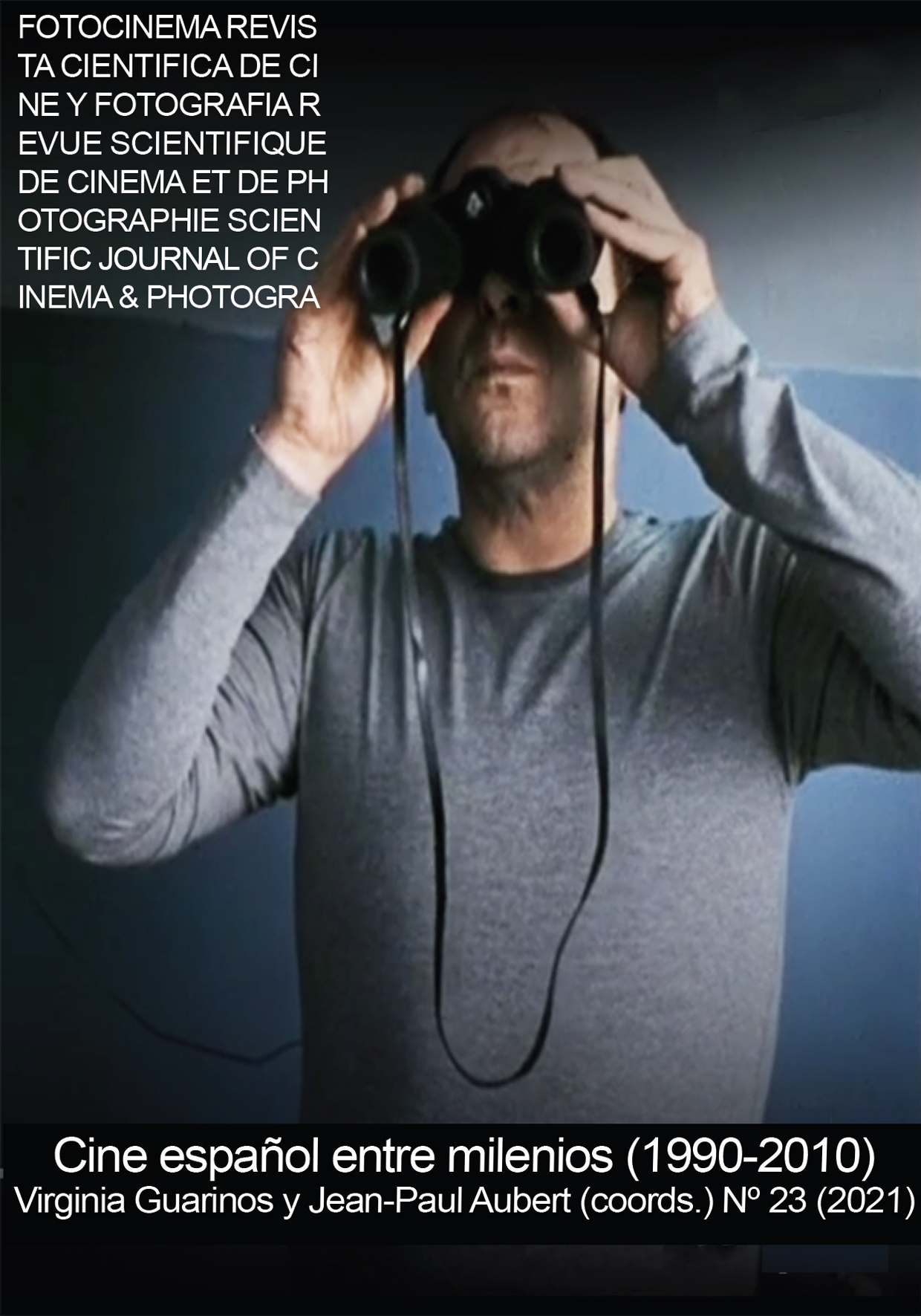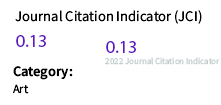Haunted Houses, Social Spaces and Surveilled Homes: Scary and Sinister Places in Spanish Cinema (1999-2012)
DOI:
https://doi.org/10.24310/Fotocinema.2021.v23i.12234Keywords:
Motion pictures, horror films, abject spaces, home, film space, fantastic filmsAbstract
This article focuses on the visual and narrative representation of abject spaces in contemporary Spanish cinema (1999-2012). Following Kristeva’s ideas (1982), the abject place is understood as locations where basic limits (the internal and the external, the private and the social, time continuity) are broken and the people who inhabit them are jeopardized or destroyed. This concept is explored through the qualitative analysis of nine film divided in three different narratives regarding dangerous or sinister places: haunted houses populated by ghosts, social spaces (orphanages and hospitals) in decay, and homes surveilled by external observers. The results show that, as whole, the Spanish films under discussion offer an image of the home characterized by insecurity, distrust and danger, reflecting somehow certain events that ha shaped the recent history of this country such as increasing urbanization, economic crisis, evictions or domestic violence
Downloads
Metrics
Publication Facts
Reviewer profiles N/A
Author statements
Indexed in
-
—
- Academic society
- N/A
- Publisher
- Universidad de Málaga
References
Aguirre, M. (2008). Geometries of Terror: Numinous Spaces in Gothic, Horror and Science Fiction. Gothic Studies, 10 (2), 1-17. DOI: https://doi.org/10.7227/GS.10.2.2
Alemán, J. L. (2010). La herencia de Valdemar. España: La Cruzada Entertainment, S.L.
Almodóvar, P.(2011). La piel que habito. El Deseo, S.A.
Amenábar, A. (2001). Los otros. Sociedad General De Cine, S.A/Las Producciones Del Escorpion, S.L.
Anuario de Cine. Resumen ejecutivo (2007). Ministerio de Cultura y Deporte. http://www.culturaydeporte.gob.es/cultura/areas/cine/mc/cdc/anos-anteriores/ano-2007.html
Bailey, D. (1999). American Nightmares: The haunted house formula in american popular fiction. Bowling Green:University of Wisconsin Press.
Balagueró, J. (2002). Darkness. España: Castelao Productions, S.A.U.
Balagueró, J. (2005). Frágiles. España/Reino Unido: Castelao Productions, S.A.U., Just Films S.L. y Future Films Ltd.
Balagueró, J. (2011). Mientras duermes. España: Mientras Duermes, A.I.E./Castelao Pictures, S.L.
Bayona, J.A. (2007). El orfanato. España: Rodar y Rodar Cine / Televisión, S.L.
Bracco, D. (2016). Las estrategias de la angustia en Mientras duermesde Jaume Balagueró: una inmersión en el corazón del mal cotidiano. Romanica Silesiana, 11 (2), 30-39. https://www.ceeol.com/search/article-detail?id=498608
Burns, S. (2012). Better for Haunts. American Art, 26 (3), 2–25. DOI:10.1086/669220
Córdoba, A. (2017). Precarious Life in the High Rise: Neoliberal Urban Interiors in Rec (2007) and Mientras duermes (2011). En M.C. DiFrancesco & D.J. Ochoa (Eds.), Gender in Spanish Urban Spaces (pp. 269-288). Cham: Palgrave Macmillan.
Cuadrado Alvarado, A. (2018). El hogar infernal. Barcelona: Editorial UOC.
Cuadrado Alvarado, A. (2020). La génesis del locus siniestro en la Barcelona del cine de Jaume Balagueró. L'Atalante. Revista de estudios cinematográficos, 0(30), 75-88. http://www.revistaatalante.com/index.php?journal=atalante&page=article&op=view&path%5B%5D=803
De la Iglesia, A. (2000). La comunidad. España: Lola 2002,S.L.
Del Toro, G. (2000). El espinazo del Diablo. España/Méjico: El Deseo, S.A. / Tequila Gang.
Díez Cobo, R. (2020). Inverted Home Architectures: Rewriting The Haunted House. Brumal. Revista De Investigación Sobre Lo Fantástico, 8 (1), DOI:https://doi.org/10.5565/rev/brumal.633.
Expósito Barea, M. y Pérez-Gómez, M. A. (2013). El apocalipsis doméstico: El fin del mundo según Jaume Balagueró. Altre Modernità, 9 (5), 92-111. DOI: https://doi.org/10.13130/2035-7680/2994
Fiddler, M. (2013). Playing Funny Games in The Last House on the Left: The uncanny and the “home invasion” genre. Crime, Media, Culture: An International Journal, 9(3), 281–299.DOI: https://doi.org/10.1177/1741659013511833
Frágiles. España /R.U.: / Just Films,S.L. / Future Films Ltd.
Gil Poisa, M. (2020). Faith as confinement. Alejandro Amenábar’s The Others (2004). En Miller, C.J. & Bowdoin Van Riper, A. (Eds.), Dark Forces at Work. Essays on Social Dynamics and Cinematic Horrors (pp. 181-192). Lanham: Lexington Books.
Gutiérrez Albilla, J. D. (2013). La piel del horror, el horror en la piel.Poder, violencia y trauma en el cuerpo (post)humano en La piel que habito. Journal of Spanish Cultural Studies, 14 (1), 70-85. DOI: https://doi.org/10.1080/14636204.2013.854610
Howell, A. (2018). The Terrible Terrace: Australian Gothic Reimagined and the (Inner) Suburban Horror of The Babadook. En Danks, A. Gaunson, S. & Kunze, P. C. (Eds.), American–Australian Cinema Transnational Connections (pp. 183-201). Cham: Palgrave Macmillan.
Kawin, B. F. (2012). Horror and the Horror Film. London: Anthem Press.
Kriesch, D. (2016). ‘They only see what they wanna see’: Traumatised Ghosts and Ghost Story Conventions in The Sixth Sense and The Others En Fleischhack, M. & Schenkel, E. (Eds.), Ghosts - or the (Nearly) Invisible Spectral Phenomena in Literature and the Media (pp- 71-85). Frankfurt: Peter Lang.
Lee, Nikki J. Y. (2013). Apartment horror: Sorum and Possessed. En Peirse, A. y Martin, D. (Eds.), Korean Horror Cinema (pp. 101-113). Edimburgo: Edinburgh University Press.
Lee, S. (2015). Lost in Liminal Space: Amnesiac and Incognizant Ghosts in Korean Drama. Mosaic: An Interdisciplinary Critical Journal, 48 (3), 125-140. DOI: 10.1353/mos.2015.0040
Lovasz, ‘Would you like to meet a ghost?’: Repetition and spectral posthumanism in Kiyoshi Kurosawa’s Kairo. Horror Studies, 9 (2), 249-263. DOI: https://doi.org/10.1386/host.9.2.249_1
Macgregor Wise, J. (2016). Surveillance and Film. Londres: Bloomsbury Publishing.
McAndrew, F. (2020). The Psychology, Geography, and Architecture of Horror: How Places Creep Us Out. Evolutionary Studies in Imaginative Culture, 4(2), 47-62. DOI:10.26613/esic.4.2.189
Messias, A. (2020). Todos los monstruos de la tierra. Bestiarios del cine y de la literatura. Madrid: Punto de vista editores.
Miller, C. J. & Bowdoin Van Riper, A. (2019) (Eds.).Horror Comes Home: Essays on Hauntings, Possessions and Other Domestic Terrors in Cinema. Jefferson: Macfarland.
Olivares Merino, J. (2019). El quiasmo como desvelo de la otredad: proyecciones especulares y distorsión de la monstruosidad en Los Otros (2001), de Alejandro Amenábar. The Grove - Working Papers On English Studies, 26, 41-70. DOI: https://doi.org/10.17561/grove.v26.a3
Pascuzzi, F. y Waters, S. (2020). The spaces and Places of Horror. Delaware: Vernon Press.
Podoshen, J. S. (2018). Home is Where the Horror Is: Wes Craven’s Last House on the Left and A Nightmare on Elm Street. Quarterly Review of Film and Video, 35 (7), 722-729.DOI: 10.1080/10509208.2018.1472535
Pueyo Zoco, V. (2013). Después del fin de la historia Estados de excepción y escenarios de emergencia en el cine de terror español contemporáneo. Arizona Journal of Hispanic Cultural Studies, 17, 29-46. DOI: 10.1353/hcs.2013.0013
Raya Bravo, I. (2020). El orfanato. En J. Sánchez Noriega (Ed.), Cine español en la era digital: emergencias y encrucijadas (pp. 329-331). Barcelona: Laertes.
Reyes, I. (2015). Espacios que asustan: narrar el horror en el cine y el cuento español contemporáneo. Tesis. University of California. https://escholarship.org/uc/item/4dm589qg
Robertson Wojcik, P. (2010). The Apartment Plot: Urban Living in American Film and Popular Culture, 1945 to 1975.Durham y Londres: Duke University Press.
Sánchez Noriega, J. (2017). La casa Malaparte: espacio fílmico y arquitectura de autor. Arte, Individuo Y Sociedad, 29(3), 463-481. DOI: 10.5209/aris.55505
Spratford, B. (2012). The readers' advisory guide to horror. Chicago: American Library Association.
Thibaudeau, P. (2013). El cuerpo, la piel y la pantalla: los territorios habitados por Pedro Almodóvar. Fotocinema. Revista científica de cine y fotografía, Nº 7, 192-208.
Zimmer, C. (2015). Surveillance Cinema. New York: New York University Press.
Downloads
Published
How to Cite
Issue
Section
License
All contents published in Fotocinema Revista científica de cine y fotografía are protected under the Creative Commons Attribution-NonCommercial-ShareAlike 4.0 International (CC BY-NC-SA 4.0) license. All about this license is available in the following link: <http://creativecommons.org/licenses/by-nc-sa/4.0>
Users can copy, use, redistribute, share and exhibit publicly as long as:
- The original source and authorship of the material are cited (Journal, Publisher and URL of the work).
- It is not used for comercial purposes.
- The existence of the license and its especifications are mentioned.
There are two sets of authors’ rights: moral and property rights. Moral rights are perpetual prerogatives, unrenounceable, not-transferable, unalienable, imprescriptible and inembargable. According to authors’ rights legislation, Fotocinema. Revista científica de cine y fotografía recognizes and respects authors moral rights, as well as the ownership of property rights, which will be transferred to University of Malaga in open access. The property rights are referred to the benefits that are gained by the use or the dissemination of works. Fotocinema. Revista científica de cine y fotografía is published in an open access form and it is exclusively licenced by any means for doing or authorising distribution, dissemination, reproduction, , adaptation, translation or arrangement of works.
Authors are responsable for obtaining the necessary permission to use copyrighted images.














13.png)



